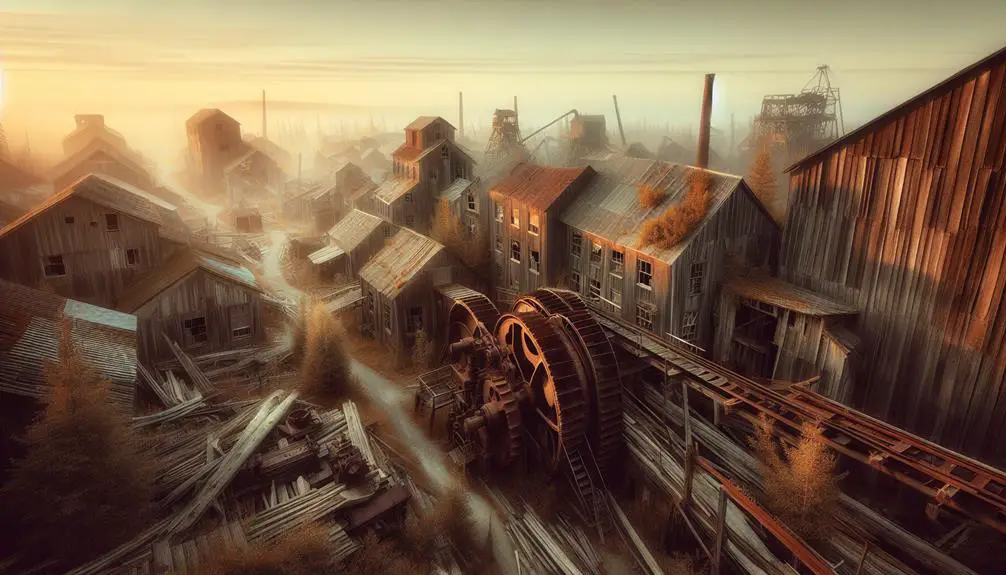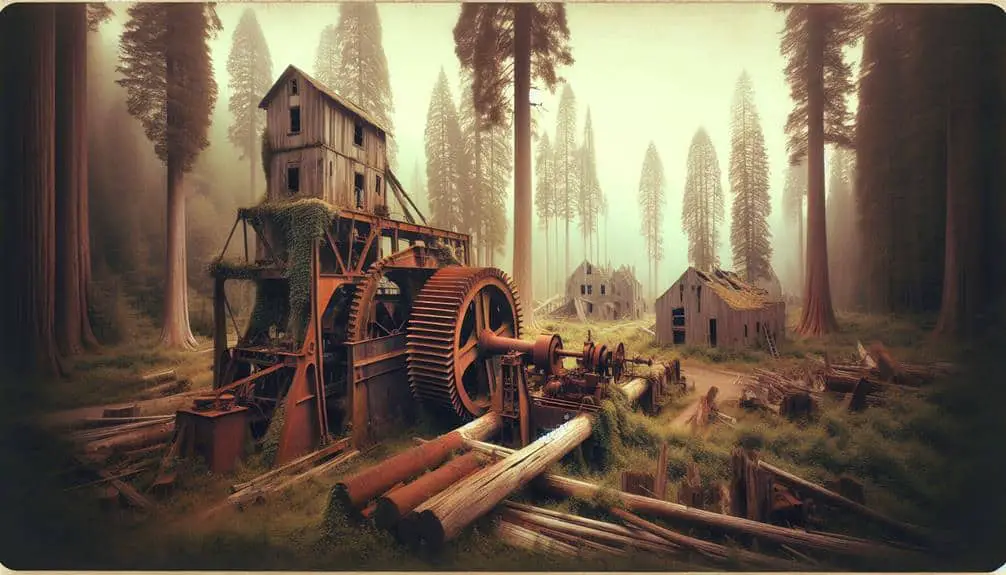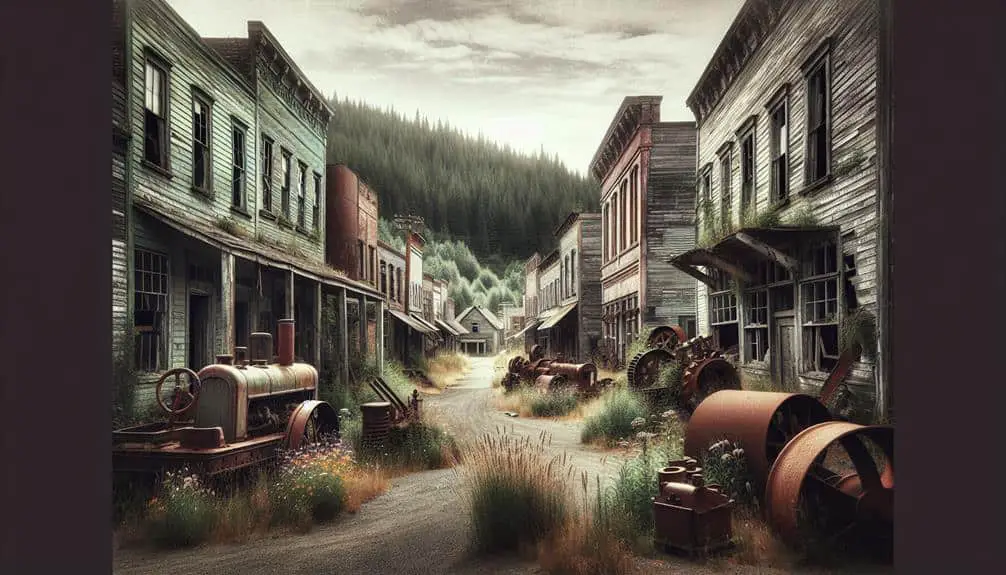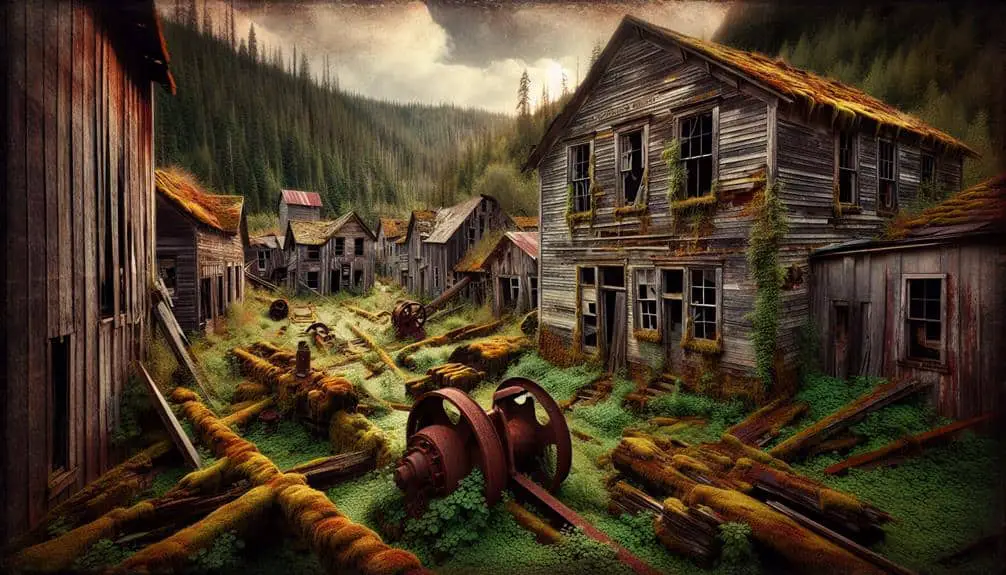In the late 19th century, sawmill towns boomed, but modern logging practices caused economic decline. Larger corporations took over, leading to rural migration. Struggling to compete, small towns became deserted. Crumbling structures and neglect show the decay process. Restoration projects are preserving these historical sites, though financial burdens remain. Decaying remains whisper tales of prosperity turned desolation, reminding us of industry's transient nature. The abandoned sawmill towns stand as eerie reminders of a bygone era. Explore the haunting remnants of America's forgotten past, where once-thriving communities now remain in silent reflection.
Key Points
- Modern logging practices led to economic decline in traditional sawmill towns.
- Larger corporations dominated the industry, causing closures and job losses.
- Abandoned sawmill towns show signs of neglect and decay over time.
- Restoration projects aim to preserve the historical significance of these towns.
- Haunting remnants of past communities serve as eerie reminders of industry's transient nature.
Rise and Fall of Sawmill Towns
Experiencing rapid growth in the late 19th century, sawmill towns across America flourished as essential centers of industry and community before facing a swift decline in the early 20th century. The economic decline of these towns was primarily attributed to the shift towards more modern and efficient logging practices that rendered the traditional sawmill operations obsolete. As larger corporations began to dominate the industry, smaller sawmill towns struggled to compete and sustain their livelihoods. This led to a significant wave of rural migration, as residents sought employment opportunities elsewhere, leaving behind once-thriving communities that now stood deserted and forgotten.
The impact of industrial changes was profound, as sawmill towns that were once bustling with activity and prosperity now lay abandoned, serving as powerful reminders of a bygone era. The remnants of these towns stand as indicators to the rise and fall of an industry that shaped the landscape of America, highlighting the cyclical nature of economic growth and decline.
Impact of Industrial Changes
With the advent of more modern and efficient logging practices, the traditional sawmill operations in America underwent a rapid transformation, leading to a significant impact on the industry and the communities it supported. The shift towards mechanization and larger-scale production resulted in economic decline for many small sawmill towns that couldn't keep up with the pace of change. As larger corporations began to dominate the industry, smaller mills struggled to compete, leading to closures and job losses in these communities. The once-thriving towns that relied on sawmills as their economic backbone faced hardships as they grappled with unemployment and a shrinking tax base.
However, amidst the economic challenges, some sawmill towns have seen a glimmer of hope through urban revitalization efforts. By repurposing old mill buildings into commercial spaces or residential areas, these communities have been able to breathe new life into their once-declining economies. Urban revitalization projects have provided opportunities for growth and development, attracting new businesses and residents to these areas, ultimately helping to revive the spirit of these abandoned sawmill towns.
Abandonment and Decay Process
The gradual erosion of once bustling sawmill towns, marked by crumbling structures and overgrown pathways, reveals the poignant narrative of abandonment and decay in America's industrial history. As economic shifts altered the landscape, these towns faced a slow decline, leading to their eventual abandonment. The decay process is evident in the boarded-up windows of once-thriving businesses, now mere shells of their former selves. Nature, reclaiming its territory, creeps through the broken pavement and unkempt gardens, highlighting the passage of time and neglect.
The decay process begins subtly, with faded signs and peeling paint, but soon escalates as roofs cave in and walls crumble. The echoes of bustling sawmills are replaced by eerie silence, broken only by the sound of wind whistling through decaying structures. Each building tells a story of economic prosperity turned to desolation, a stark reminder of the impermanence of human endeavor. Witnessing the decay process firsthand serves as a poignant reminder of the cyclical nature of progress and decline in America's industrial history.
Preservation Efforts and Challenges
Amid the desolate remnants of America's abandoned sawmill towns, the task of preserving their historical significance poses intricate challenges requiring innovative solutions. Restoration projects play a vital role in maintaining the authenticity of these sites, aiming to capture the essence of a bygone era. However, the financial burden often associated with such endeavors can hinder progress. To overcome this obstacle, community engagement becomes paramount. Involving local residents and historical preservation groups not only provides additional resources but also fosters a sense of ownership and pride in the restoration process.
One of the main challenges faced in preservation efforts is striking a balance between maintaining the historical integrity of the sawmill towns and adapting them to serve modern needs. This delicate dance requires thoughtful planning and expertise to safeguard that the essence of these towns isn't lost in the pursuit of functionality. By embracing innovative approaches and garnering support from the community, these once-thriving sawmill towns can be revitalized, allowing their stories to be preserved for generations to come.
Haunting Remnants of Forgotten Past
Ethereal echoes of a forgotten era linger among the decaying structures of America's abandoned sawmill towns, whispering tales of a bygone industry's rise and fall. As you explore these ghostly shadows of the past, remnants of once bustling communities reveal themselves through crumbling buildings and rusted machinery. Each creaking floorboard and peeling paint layer serves as a powerful reminder of the lives lived in these now desolate areas.
Walking through these forgotten relics, you can almost hear the hum of saws and the shouts of workers that once filled the air. Nature has begun to reclaim what was left behind, weaving its way through broken windows and over collapsed roofs. The juxtaposition of life slowly returning to these abandoned spaces while the echoes of the past remain is both unsettling and enthralling.
These haunting remnants stand as a proof to the transient nature of industry and human settlement. They serve as a stark reminder of the impermanence of our creations and the resilience of nature in reclaiming what was once lost.
Frequently Asked Questions
What Were the Living Conditions Like for the Workers and Families in Sawmill Towns?
In sawmill towns, living conditions were harsh. You toiled endlessly, while families struggled to make ends meet. Community dynamics were strained, with inequality and hardships shaping daily life. It was a tough existence for all.
How Did the Decline of the Lumber Industry Affect the Local Economy of Sawmill Towns?
When the lumber industry declined, sawmill towns faced economic hardships due to job losses and decreased revenue. This had a significant impact on communities, leading to poverty, migration, and a struggle to find alternative sources of income.
Were There Any Environmental Consequences of the Sawmill Operations in These Towns?
Environmental impact of sawmill operations in these towns was significant. Pollution affected community health, wildlife habitats, and natural resources. Lack of regulations harmed ecosystems. Balancing economic development with historical preservation is important for sustainable growth and restoration efforts.
What Role Did the Railroad Play in the Development and Eventual Abandonment of Sawmill Towns?
Back in the day, railroads were the lifeblood of economic growth. The steel tracks connected sawmill towns, fueling urban development. But when the trains stopped chugging, the towns were left deserted, a stark reminder of changing times.
Are There Any Unique Architectural Features or Landmarks That Still Remain in These Abandoned Sawmill Towns?
Explore these abandoned sawmill towns to discover unique architectural remnants like old mill buildings and worker housing. Historic preservation efforts aim to restore these landmarks for urban exploration and photography enthusiasts to enjoy.



